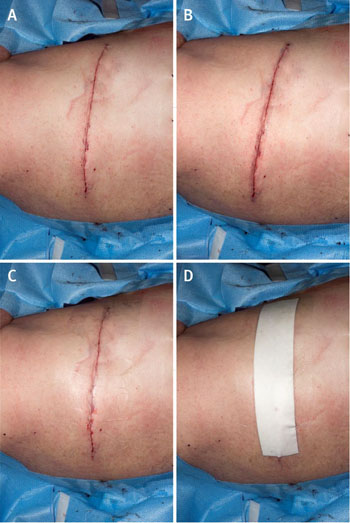Uncertainty Continues on Role of Dressings in Infection Protection
By HospiMedica International staff writers
Posted on 08 Jun 2016
There is insufficient evidence to know whether dressings reduce the risk of surgical site infection (SSI) in closed primary surgical wounds, claims a new study.Posted on 08 Jun 2016
Researchers at the University of Bristol (United Kingdom) searched a 2014 Cochrane systematic review of 20 randomized, controlled trials that summarized the evidence for the use of dressings to prevent SSI in people with closed primary surgical wounds. All were at an unclear or high risk of bias, and only two studies compared leaving wounds exposed with applying a dressing. The remainder compared one type of dressing with another, and none reviewed tissue adhesive as a dressing.

Image: A closed primary surgical wound without a dressing (a), with tissue adhesive (b), with an adherent and transparent dressing (c), and with an adherent and absorbent dressing (d) (Photo courtesy of BMJ).
To supplement the Cochrane review, the researchers systematically searched for further randomized controlled trials evaluating application of tissue adhesive as a dressing on closed primary surgical wounds, screening 319 abstracts, 19 full papers, and two trials. They also searched the Cochrane Wounds Group Specialized Register, Medline, Embase, and other databases for trials that compared immediate postoperative application of wound dressings with tissue adhesive as a dressing to closed primary surgical wounds.
The results showed there is insufficient evidence to know whether dressings reduce the risk of SSI wound infection; and that there is insufficient evidence to conclude which type of dressing reduced infection, or whether dressings were needed at all. Because of the lack of evidence, the researchers recommend that current decision making about dressings may need to be led by practical issues, such as wound symptom management and costs, rather than SSI. The study was published on May 24, 2016, in BMJ.
“Without evidence of the superiority of more expensive dressings, and with anecdotal reports of the convenience of dressings for patients and health care staff, the use of basic adhesive (with minimal absorbency) dressings at a cost of a few pence per dressing on a closed primary surgical wounds is pragmatic,” concluded study author Professor Jane Blazeby, MD. “An exception to this recommendation would be settings in which it is standard practice not to use dressings, and pediatric surgery may constitute such an exception, if the removal of dressings causes undue distress to children.”
Related Links:
University of Bristol














